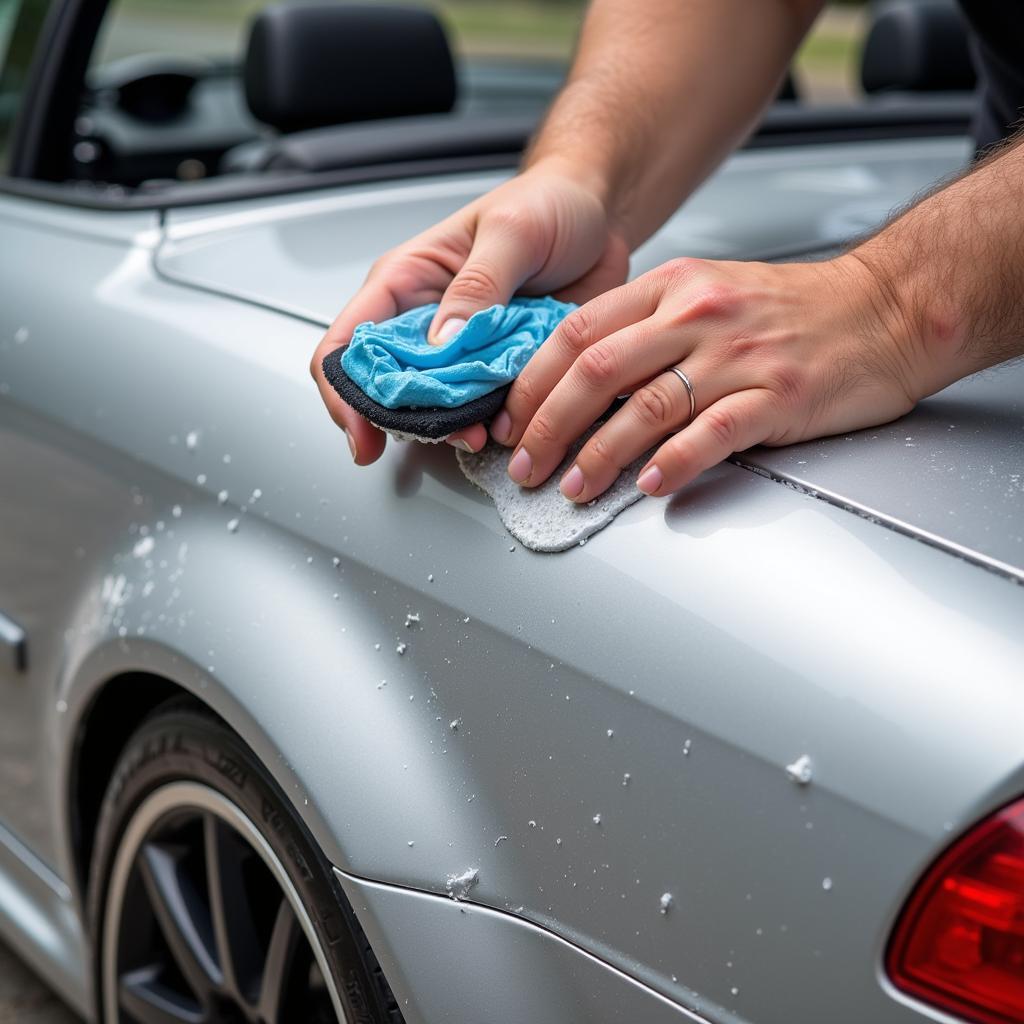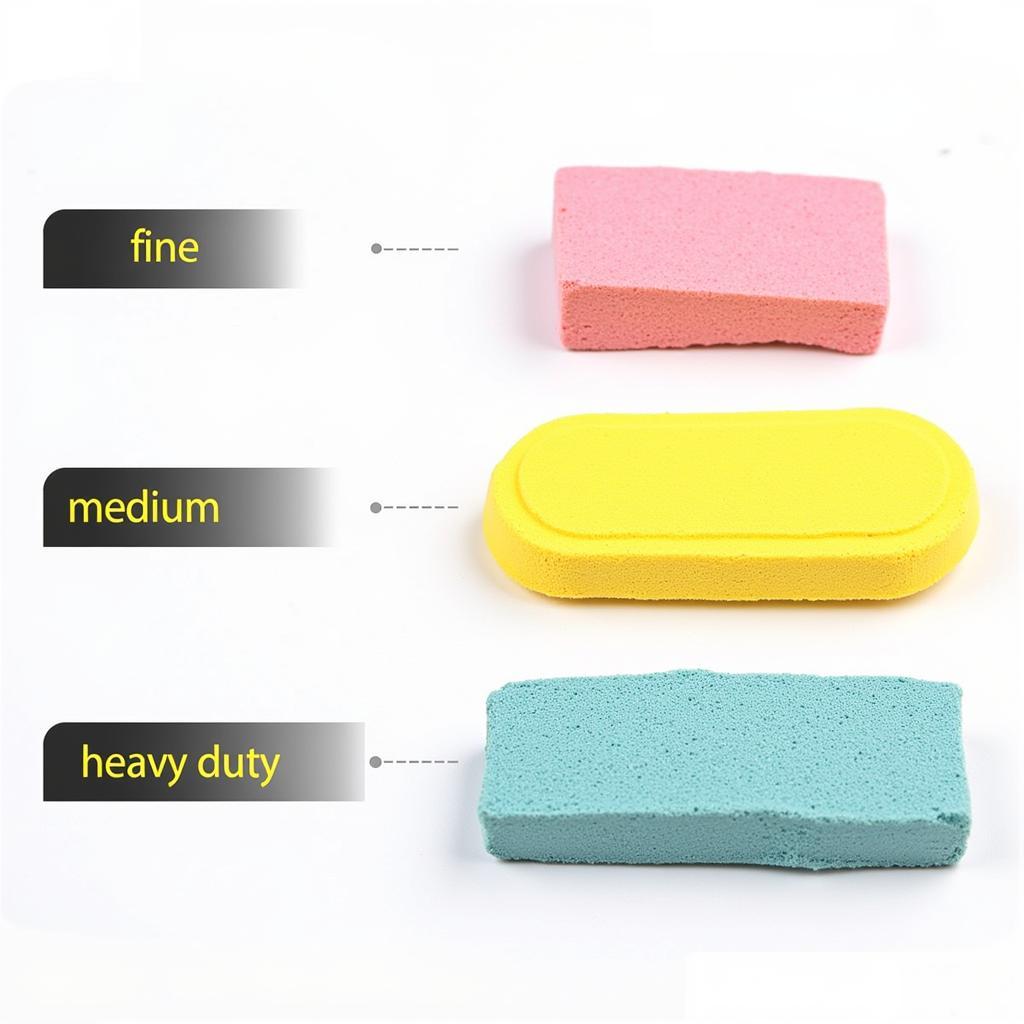Car Detailing Clay is a crucial step in achieving a truly flawless finish on your vehicle. It goes beyond a simple wash and wax, removing embedded contaminants that traditional methods leave behind. This guide delves into the intricacies of car detailing clay, providing you with everything you need to know to achieve professional-grade results.  Applying Car Detailing Clay
Applying Car Detailing Clay
Why Use Car Detailing Clay?
After washing and drying your car, you might think it’s clean. Think again. Microscopic contaminants like industrial fallout, brake dust, tree sap, and even paint overspray can become embedded in your car’s clear coat. These contaminants create a rough surface that dulls the paint and prevents waxes and sealants from bonding properly. claybar car detailing is designed to safely lift and remove these stubborn particles, leaving behind a perfectly smooth surface.
What are the Benefits?
Using car detailing clay offers several key advantages:
- Enhanced Gloss: A smooth surface reflects light more evenly, resulting in a deeper, more vibrant shine.
- Improved Paint Protection: By removing contaminants, clay allows waxes and sealants to bond more effectively, providing longer-lasting protection.
- Smoother Finish: Clay leaves your car’s paint feeling incredibly smooth, like glass.
- Prevents Swirl Marks: By removing embedded contaminants, you reduce the risk of creating swirl marks during the polishing process.
Choosing the Right Car Detailing Clay
There are various types of car detailing clay available, ranging from fine to medium to heavy-duty. The best choice depends on the severity of the contamination and the condition of your paint.
Types of Car Detailing Clay:
- Fine Grade Clay: Ideal for lightly contaminated vehicles and regular maintenance.
- Medium Grade Clay: Suitable for moderately contaminated vehicles and those with slightly rougher paint.
- Heavy-Duty Clay: Designed for heavily contaminated vehicles or those with significant surface imperfections.
 Different Grades of Car Detailing Clay
Different Grades of Car Detailing Clay
How to Use Car Detailing Clay
Using car detailing clay is a straightforward process, but proper technique is essential to avoid causing damage.
Step-by-Step Guide:
- Wash and Dry Your Car: Thoroughly wash and dry your vehicle to remove loose dirt and debris.
- Knead the Clay: Warm the clay in your hands and knead it into a flat, pancake-like shape.
- Lubricate the Surface: Spray a generous amount of clay lubricant onto a small section of the car’s paint.
- Glide the Clay: Gently glide the clay across the lubricated surface using back-and-forth motions. Avoid applying pressure.
- Fold and Knead: As the clay becomes contaminated, fold it over and knead it to expose a clean surface.
- Inspect and Repeat: Inspect the area for smoothness. Repeat the process until the clay glides smoothly across the surface.
- Wipe Clean: Wipe the residue from the clay lubricant with a clean microfiber towel.
- Wax or Seal: Once the entire car has been clayed, apply a high-quality wax or sealant to protect the paint.
clay bars for car detailing] can make a huge difference in the overall look and feel of your vehicle.
When Should You Clay Bar Your Car?
A common question is how often you should use car detailing clay. While there’s no set schedule, it’s generally recommended to clay bar your car every six months to a year, or before applying a new coat of wax or sealant. car detailing in clayton] offers professional detailing services if you’re unsure.
“Car detailing clay is a game-changer for anyone serious about car care,” says renowned detailing expert, John Smith, founder of Smith’s Auto Detailing. “It’s the secret to achieving that truly showroom-worthy shine.”
Conclusion
Car detailing clay is a valuable tool for anyone seeking a flawless finish on their vehicle. By removing embedded contaminants, car detailing clay enhances gloss, improves paint protection, and provides a truly smooth surface. Follow the steps outlined in this guide, and you’ll be well on your way to achieving professional-grade results. clay for car detailing] is an investment in your car’s appearance and long-term protection.
FAQ
- Is car detailing clay safe for all paint types? Yes, when used correctly with proper lubrication.
- Can I reuse car detailing clay? Yes, as long as you fold and knead it to expose a clean surface and store it properly.
- What is the best clay lubricant to use? Dedicated clay lubricants are recommended, but a quick detailer can also be used.
- How much clay do I need for one car? One or two clay bars are usually sufficient for a single car.
- How do I store car detailing clay? Store it in an airtight container or its original packaging to prevent it from drying out.
- What if I drop the clay on the ground? Discard it immediately, as it can pick up dirt and debris that can scratch your paint.
- Can I use car detailing clay on glass? Yes, it can be used to remove stubborn contaminants from glass surfaces.
“Don’t underestimate the power of car detailing clay,” adds Jane Doe, lead detailer at Pristine Auto Spa. “It’s a simple yet effective way to dramatically improve the appearance of your car.” car detailing virginia mn] may offer clay bar treatments as part of their services.
For further information, explore our other articles on claybar car detailing.
Need help? Contact us via WhatsApp: +1(641)206-8880, Email: [email protected]. We have a 24/7 customer support team.

Leave a Reply